
Outdoor Red Plants: A Guide to Growing Vibrant Garden Color
Are you looking to add a vibrant pop of color to your garden? In this post, we will showcase a variety of outdoor red plants that can enhance your outdoor landscape and provide tips on how to care for them and incorporate them into your garden design. Whether you’re a seasoned gardener or just starting out, these red plants will add a beautiful and eye-catching element to your outdoor space.
When it comes to landscaping, few colors make as bold a statement as red. Whether you’re aiming for a fiery focal point or subtle accents, incorporating outdoor red plants into your garden can elevate its visual appeal and add vibrancy to your outdoor space. Does your garden lack that certain oomph? Yearning for a splash of color that invigorates the senses? Look no further than the fiery world of red plants! From dazzling blooms to striking foliage, incorporating red flora into your landscape design injects instant vibrancy and visual interest.
Table of Contents
ToggleIntroduction to the power of red plants in outdoor landscapes
The Power of Color in Gardening and Landscaping
In the world of gardening and landscaping, color plays a pivotal role in creating captivating outdoor spaces. Among the spectrum of hues, red stands out as a bold and dynamic choice, capable of commanding attention and infusing landscapes with energy and vitality. The power of red plants in outdoor landscapes lies not only in their striking appearance but also in their ability to evoke a range of emotions and set the tone for the garden’s ambiance.
Red Plants: Nature’s Exclamation Points
Red plants are like nature’s exclamation points, drawing the eye and adding drama to garden beds, borders, and containers. Whether showcased as focal points or used as accents amidst a sea of greenery, red plants have a transformative effect on outdoor landscapes, elevating them from ordinary to extraordinary. From fiery blooms to crimson foliage, the diverse array of red plants offers endless possibilities for creating stunning visual displays that captivate the senses and inspire admiration.
The Symbolism and Emotion of Red
But the allure of red plants goes beyond their aesthetic appeal. Red is a color rich in symbolism and significance, representing passion, energy, and vitality. In the garden, red plants can evoke feelings of excitement, warmth, and intensity, creating a sense of drama and intrigue. Whether used to create a romantic garden retreat, a vibrant urban oasis, or a bold statement in a contemporary landscape, red plants have the power to convey a wide range of emotions and evoke a sense of wonder and delight.
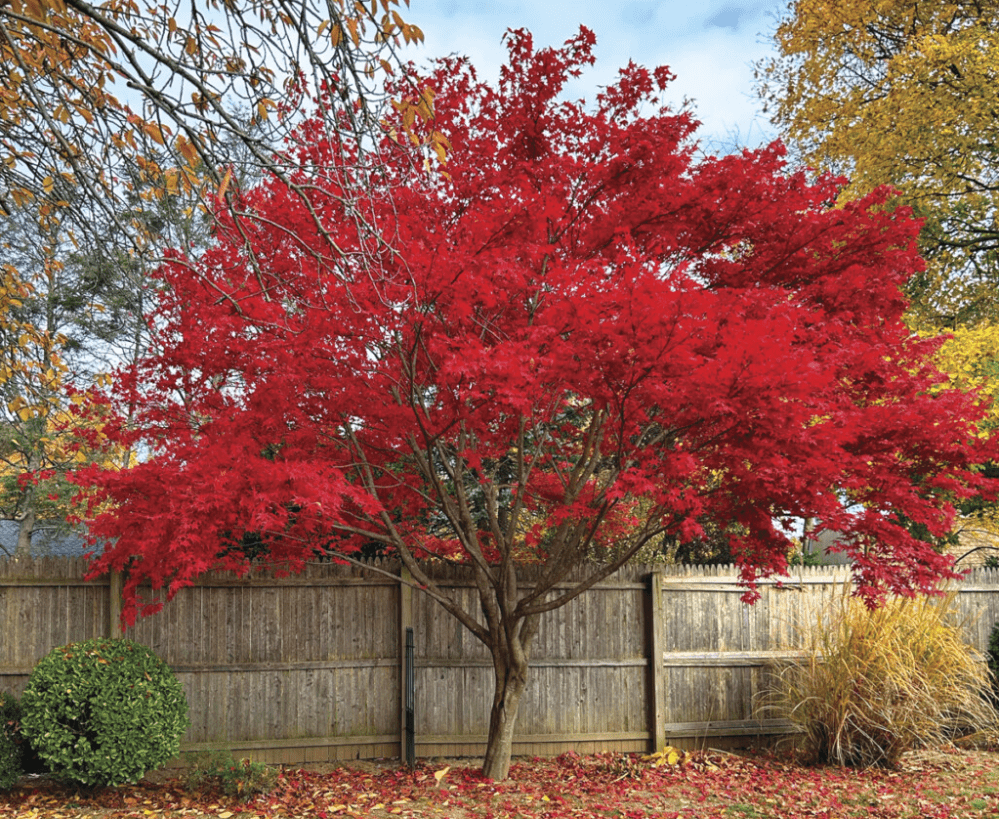
Attracting Pollinators: The Ecological Benefits of Red Plants
Moreover, red plants are not only visually striking but also attract beneficial pollinators such as hummingbirds, butterflies, and bees. Their vibrant blooms serve as beacons in the garden, inviting these winged visitors to partake in the nectar-rich rewards. By incorporating red plants into outdoor landscapes, gardeners can not only enhance the beauty of their surroundings but also support biodiversity and ecological balance.
Exploring the World of Red Plants
In this guide, we’ll explore the diverse world of red plants and discover the myriad ways in which they can be used to create captivating outdoor landscapes. From classic favorites like roses and geraniums to lesser-known gems like red hot poker and crocosmia, we’ll delve into the characteristics, care requirements, and design possibilities of a wide range of red plants. Whether you’re a seasoned gardener looking to add a pop of color to your landscape or a novice enthusiast eager to explore the possibilities, join us on a journey into the power of red plants in outdoor landscapes.
Types of red plants for outdoor gardens and landscapes
Imagine your garden. Lush greenery, perhaps a smattering of colorful blooms, but something feels…missing. It lacks that spark, that jolt of vibrancy that truly captures the eye. This, my friend, is where the power of red plants comes in. Red isn’t just a color; it’s a statement, a burst of energy that transforms your outdoor space from pleasant to phenomenal. Here’s why incorporating red plants into your landscape design is a guaranteed recipe for success:
Visual Pop
Red is the color of passion, excitement, and undeniable drama. Red plants instantly grab attention, becoming focal points that draw the eye and create a sense of vibrancy. Imagine a sea of red salvia dancing in the breeze, or a fiery red Japanese maple casting a dramatic silhouette against the evening sky.
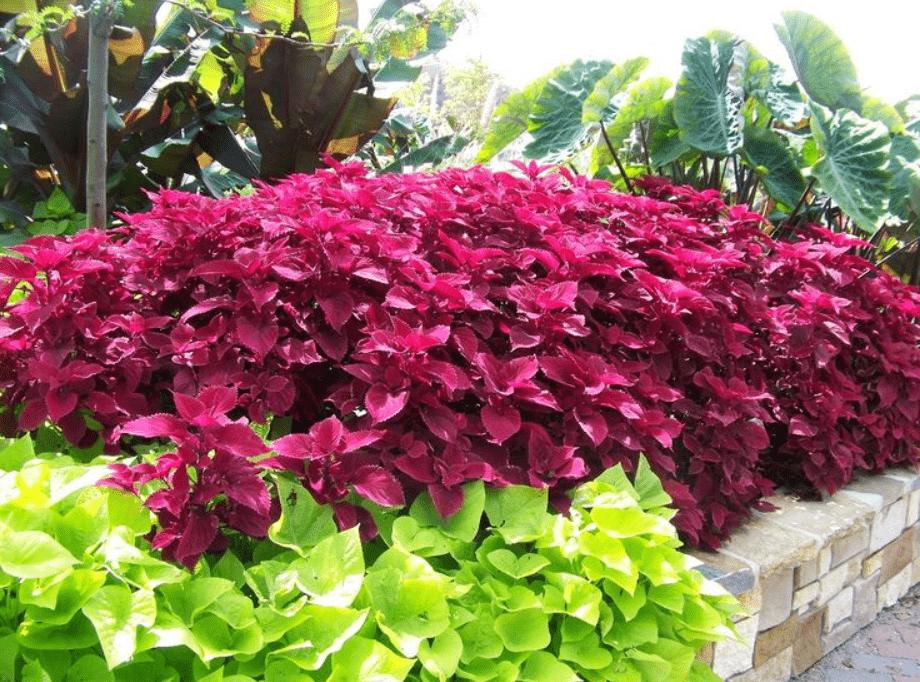
Year-Round Interest
Red doesn’t have to be confined to blooms! Many red plants boast striking foliage that adds a captivating element throughout the year. Red cordylines with their architectural sword-shaped leaves add a touch of the exotic, while burgundy coleus brings a pop of color to shady areas, even after the summer flowers have faded.
Versatility Unbound
The beauty of red plants lies in their diversity. From the classic elegance of red roses to the architectural grandeur of red Japanese maples, there’s a red plant to suit every taste and garden style. Tall, majestic trees, vibrant summer blooms, low-maintenance shade solutions – the options are endless!
Pollinator Paradise
Did you know that many red flowers are irresistible to pollinators like butterflies and hummingbirds? Red salvia, red cannas, and red tulips provide a delightful feast for these vital creatures, adding another layer of life and movement to your garden.
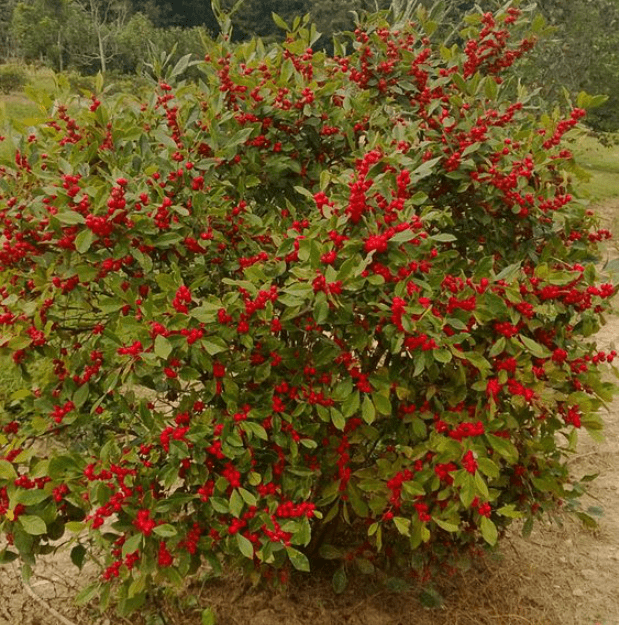
Beyond Flowers
The power of red isn’t limited to blooms. Red ornamental grasses like muhly grass with its feathery plumes, or red-berried shrubs like winterberry that offer a burst of color even after the leaves have fallen, all contribute to the year-round impact of red in your landscape.
Red isn’t just a color; it’s a design tool with the power to transform your garden. Get ready to unlock a world of fiery beauty, vibrant blooms, and captivating foliage. The next chapter in your garden’s story awaits, waiting to be splashed with the magic of red. Let’s get started!
Here’s a closer look at some of the many red plants that can add a pop of color and vibrancy to your outdoor space:
Blooming Beauties
Red Roses (Classic Choice)
Timeless and undeniably elegant, red roses add a touch of romance and sophistication to any garden. Choose from a wide variety of rose bush types, climbing varieties for walls or trellises, or miniature roses for borders.
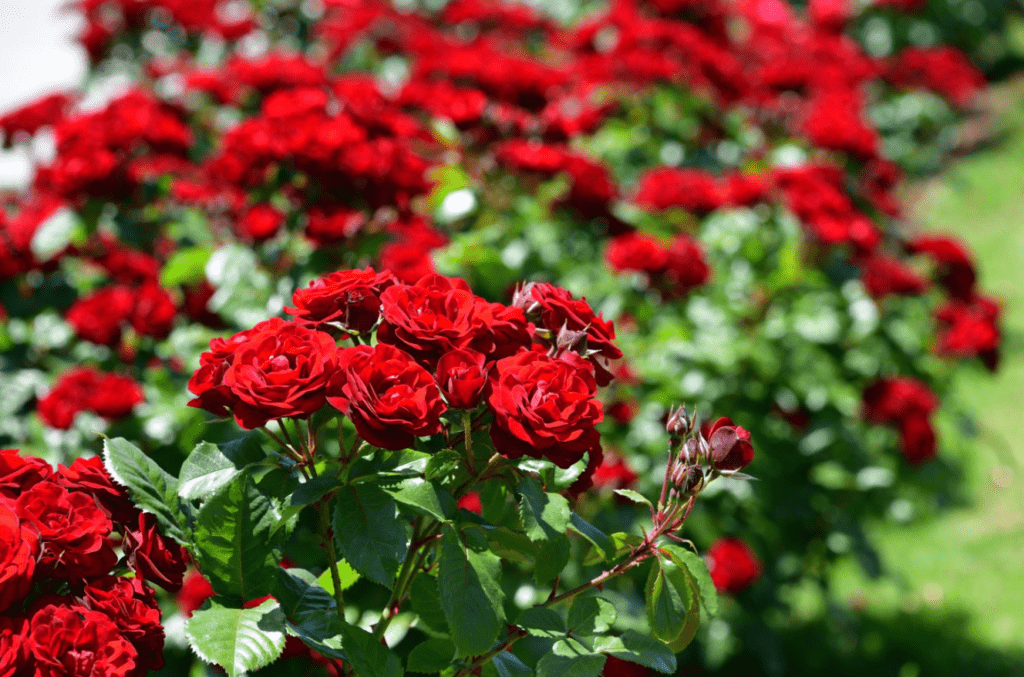
Dahlias (Showstopping Displays)
These vibrant summer bloomers come in a dazzling array of shapes and sizes, with single, double, and collarette varieties in shades ranging from scarlet to cherry red. Dahlias are perfect for creating bold focal points in borders or containers.
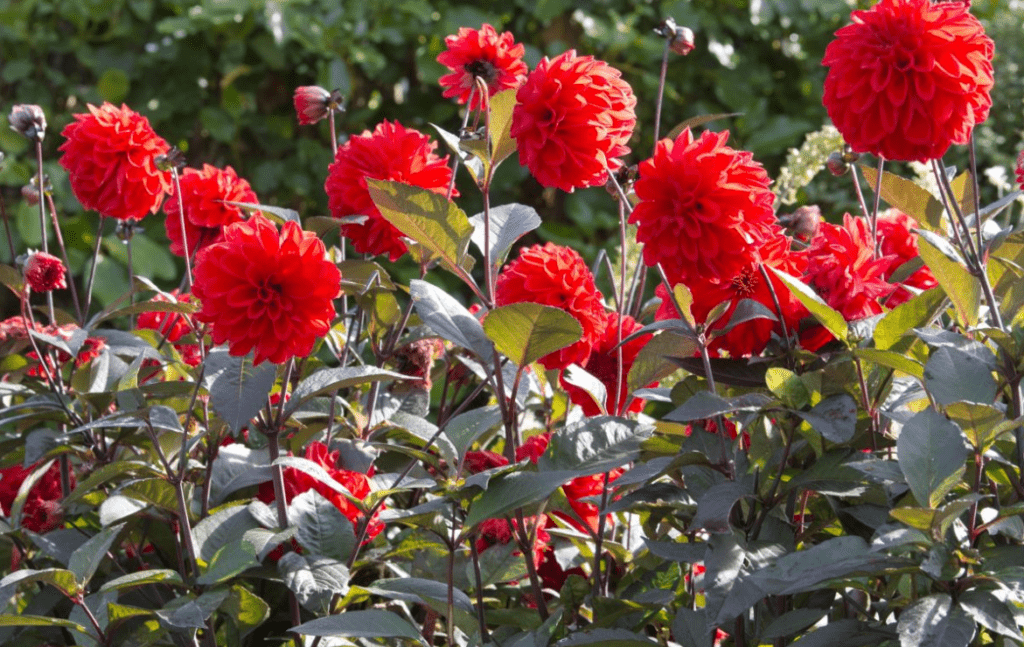
Red Salvia (Long-lasting Color)
A favorite among hummingbirds and butterflies, red salvia boasts trumpet-shaped blooms that flower continuously throughout summer and into fall. This low-maintenance plant thrives in hot, sunny locations and adds a burst of color to borders, beds, or containers.
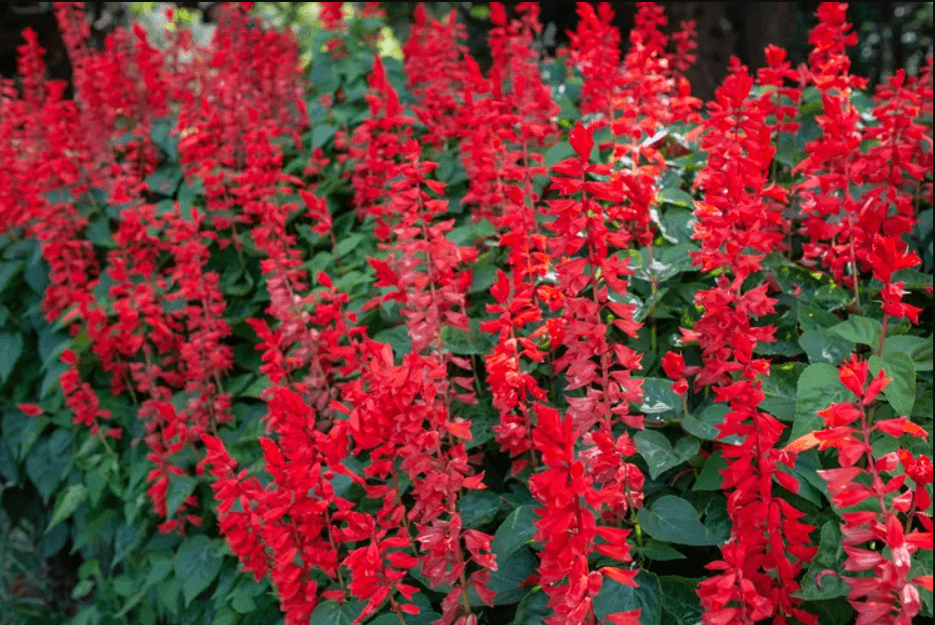
Red Canna Lilies (Tropical Flair)
Upright and architectural, red canna lilies bring a touch of the tropics to your garden. Featuring bold, canna lily foliage in shades of green or bronze and vibrant red blooms, these striking plants make excellent focal points or background plantings.
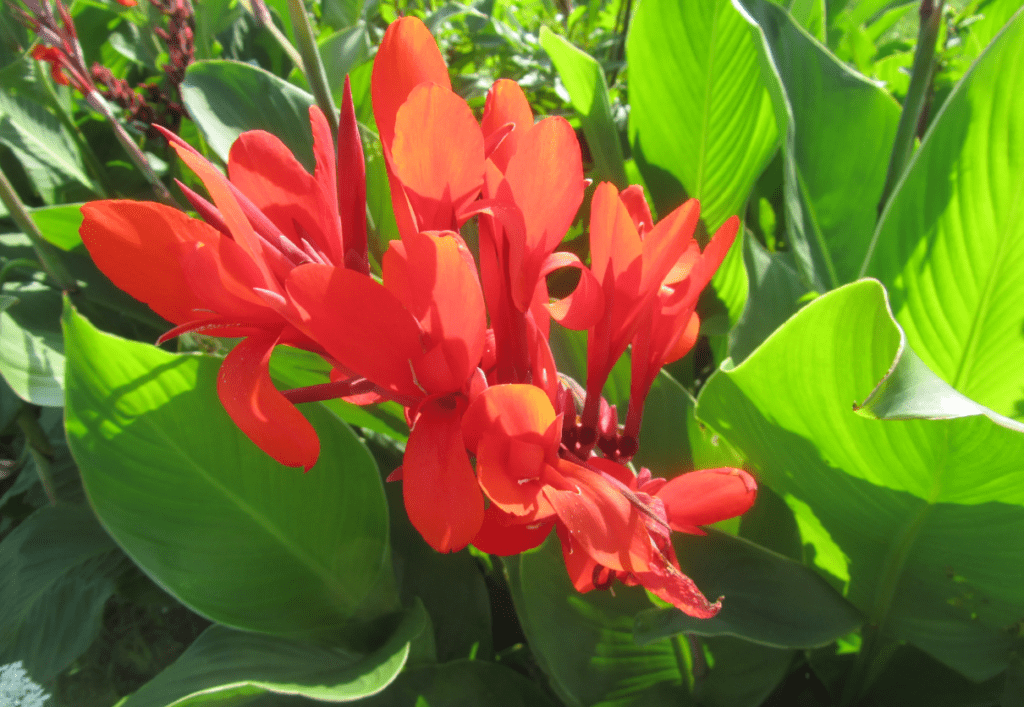
Red Tulips (Springtime Spectacle)
A harbinger of spring, red tulips offer a jolt of color as they emerge from winter’s slumber. Plant a sea of red tulips in beds or borders for a breathtaking display, or use them to add pops of color in containers.
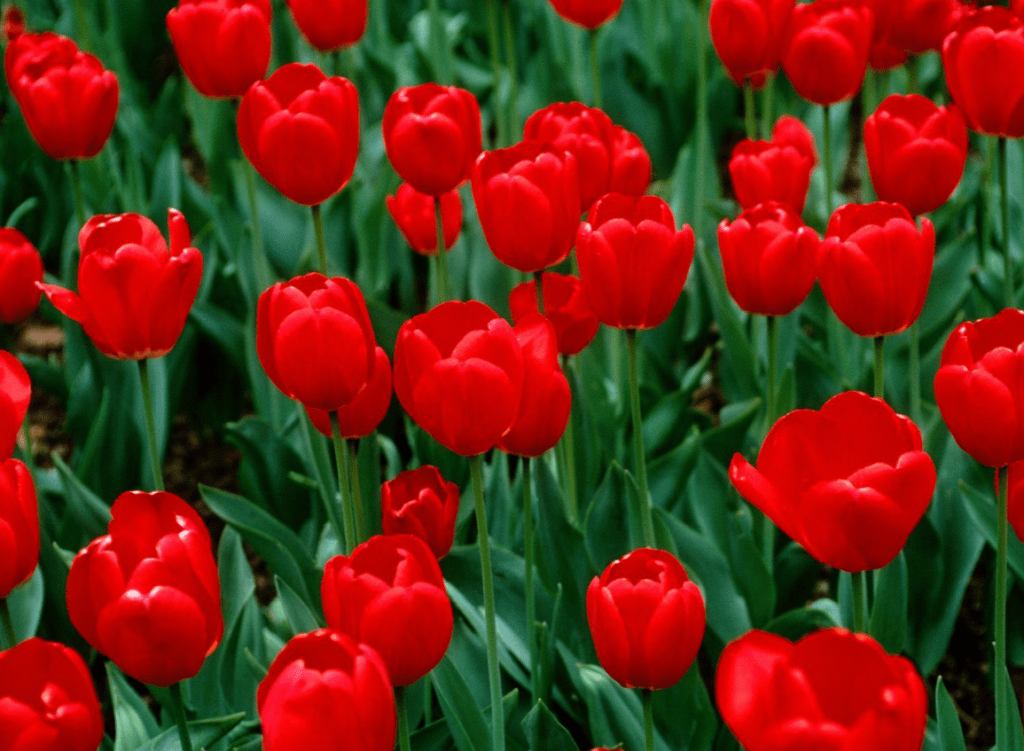
Tips for caring for red plants in your garden
Red plants add a fiery punch to your landscape, but keeping them looking their best requires a bit of know-how. Here are some essential tips to ensure your red plants thrive and continue to bring vibrant life to your garden:
Planting Power
- Location, Location, Location: Before planting, understand the sunlight needs of your chosen red plant. Sun-loving varieties like red roses and salvia need at least 6-8 hours of direct sunlight daily, while shade-tolerant options like coleus prefer dappled light or filtered sun.
- Dig in Right: Prepare the planting hole to be at least twice the width of the plant’s root ball. Amend the soil with compost or organic matter for better drainage and nutrient retention.
- Spacing it Out: Follow the recommended spacing guidelines for each plant type to ensure proper air circulation and prevent overcrowding.
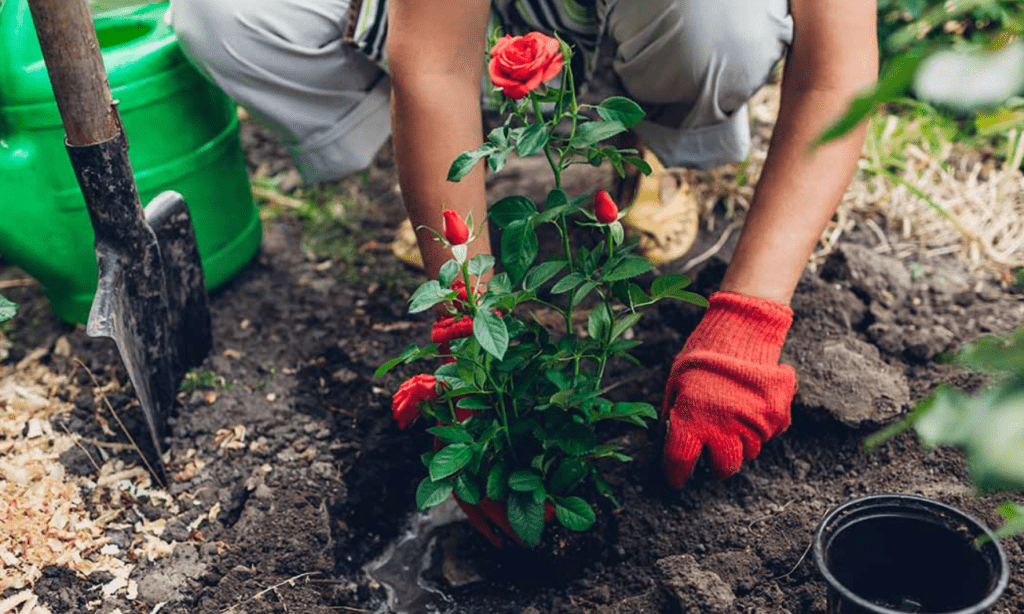
Watering Wisdom
- Know Your Plant’s Thirst: Red plants have varying water needs. Roses, for example, require regular watering, while red cannas are more drought-tolerant. Water deeply when the top inch of soil feels dry, and avoid overwatering, which can lead to root rot.
Feeding Frenzy
- Fueling Fiery Blooms: Most red flowering plants benefit from regular feeding during the growing season. Use a balanced fertilizer formulated for flowering plants, following the recommended dosage and frequency on the label.
- Don’t Overdo It: Excessive fertilization can lead to leggy growth and fewer blooms. Less is often more when it comes to feeding your red plants.
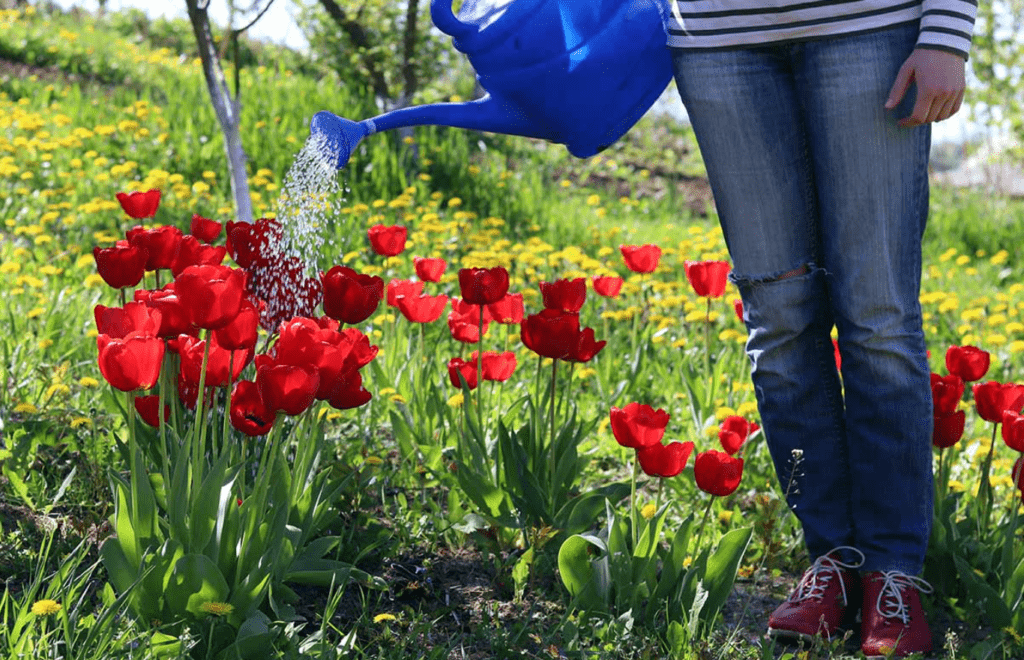
Seasonal TLC
- Winter Woes: For frost-sensitive red plants like red cannas, dig them up before the first frost and store them indoors in a cool, dark location. Alternatively, you can mulch heavily around the base of the plant to protect the roots in the ground.
- Spring Cleaning: In early spring, remove any dead or diseased leaves or stems from your red plants. For some plants like red salvia, light pruning can promote bushier growth and more blooms.
Extra Care Tips
- Mulch Magic: Apply a layer of organic mulch around the base of your red plants to retain moisture, suppress weeds, and regulate soil temperature.
- Deadheading Delights: For continuous blooms, deadhead spent flowers from your red flowering plants. This encourages the plant to produce more flowers.
- Pest Patrol: Keep an eye out for common garden pests like aphids or spider mites.
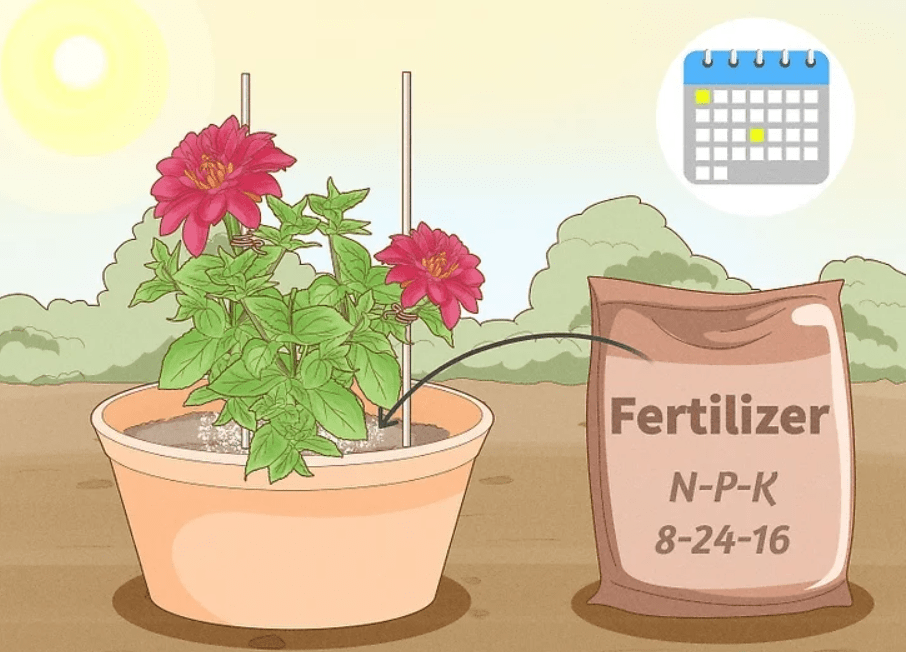
By following these simple tips, you can ensure your red plants stay healthy, vibrant, and keep your garden bursting with color throughout the season. Remember, a little care goes a long way in keeping the fiery magic of red plants alive in your outdoor haven!
Design ideas for incorporating red plants into your outdoor space
Red plants are like exclamation points in your garden design, adding drama, vibrancy, and a touch of the unexpected. But how do you integrate them seamlessly to create a cohesive and stunning outdoor space? Here are some design ideas to spark your creativity and help you unlock the full potential of red in your landscape:
Focal Point Fireworks
- Red Doorstopper: Plant a bold red Japanese maple or a vibrantly flowering red canna lily as a focal point near your entryway. This fiery welcome sets the tone for the rest of your garden and creates a dramatic first impression.
- Color in the Corners: Break up empty corners with a striking red shrub like a burgundy barberry or a red weigela. The pop of color adds visual interest and balances the overall design.
Border Bonanza
- Scarlet Symphony: Create a stunning summer border by planting red salvia, red phlox, and red dianthus together. The combination of heights, textures, and shades of red creates a visually captivating display.
- Mixed Match Magic: Don’t be afraid to mix red with other colors! Pair red tulips with yellow daffodils for a cheerful spring border, or combine red roses with lavender for a touch of classic elegance.
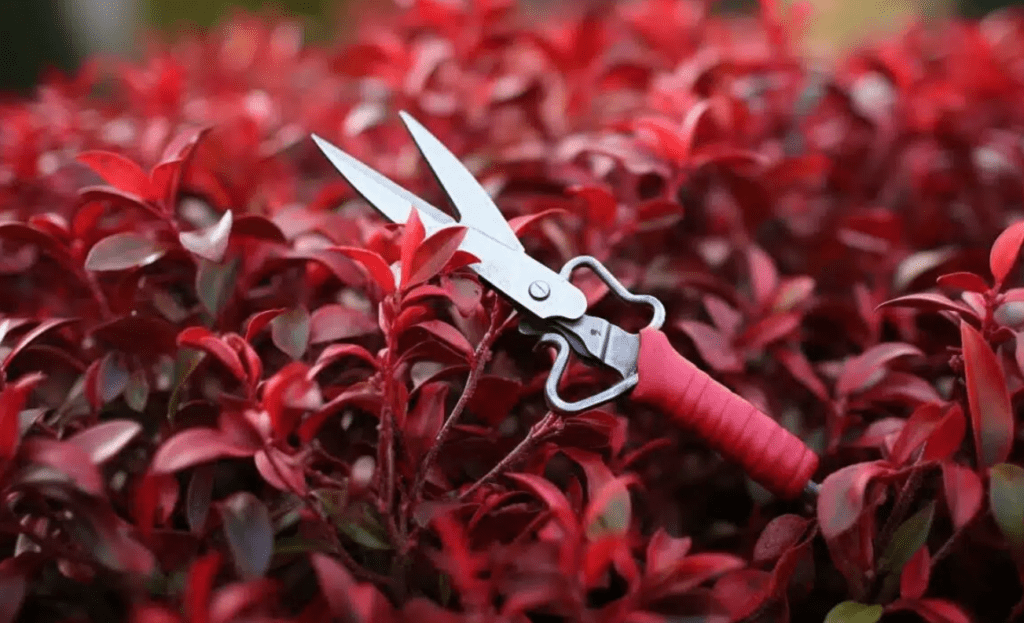
Container Captivation
- Fiery Patio Powerhouse: Liven up your patio or balcony with red container plantings. Use red geraniums, red impatiens, or a combination of red and white blooms for a vibrant display.
- Throne of Red: Elevate a potted red Japanese maple or red cordyline australis on a stand to create a dramatic focal point on your patio or deck.
Vertical Drama
- Climbing Companions: Train a red climbing rose variety like Don Juan or Crimson Cascade up a trellis or wall for a vertical burst of color.
- Hanging Basket Extravaganza: Fill hanging baskets with red trailing petunias, red verbena, or red fuchsias for a cascading display of fiery blooms.
Thinking Beyond Blooms
- Red Foliage Flair: Don’t underestimate the power of red foliage! Plant red cordylines or burgundy coleus alongside green shrubs or perennials for a striking textural contrast that adds interest throughout the year.
- Winter Wonderland: Brighten up your winter landscape with red twig dogwood or winterberry shrubs. The vibrant red stems add a pop of color even after the leaves have fallen.
Remember:
- Balance is Key: While red is a powerful color, use it strategically to avoid overwhelming the eye. Balance red plants with neutral tones like green and white for a more harmonious design.
- Consider Scale: Choose plants that are proportional to the size of your garden. Dwarf red Japanese maples are perfect for smaller gardens, while taller varieties can create a dramatic statement in larger spaces.
- Let There Be Light! Understand the light requirements of each red plant you choose and group them accordingly. This ensures optimal growth and a vibrant display of color.
By incorporating these design ideas and using your creativity, you can transform your garden into a vibrant haven where the fiery magic of red plants takes center stage. So, embrace the boldness of red and get ready to watch your outdoor space blossom with life and color!
The impact of adding red plants to your garden
Red plants are more than just splashes of color; they’re design tools with the power to completely transform your outdoor space. From the classic elegance of red roses to the architectural drama of red Japanese maples, incorporating red flora into your landscape unlocks a world of possibilities.
A Feast for the Senses
Red instantly grabs attention, injecting vibrancy and visual interest into your garden. Imagine a fiery red canna lily swaying in the summer breeze, or a border overflowing with red salvia buzzing with happy pollinators. Red plants are conversation starters, guaranteed to make your garden unforgettable.
Year-Round Appeal
The beauty of red goes beyond blooms. Many red plants boast striking foliage that adds a captivating element throughout the year. Red cordylines with their architectural sword-shaped leaves add a touch of the exotic, while burgundy coleus brings a pop of color to shady areas, even after the summer flowers have faded. With red plants, your garden stays captivating all season long.
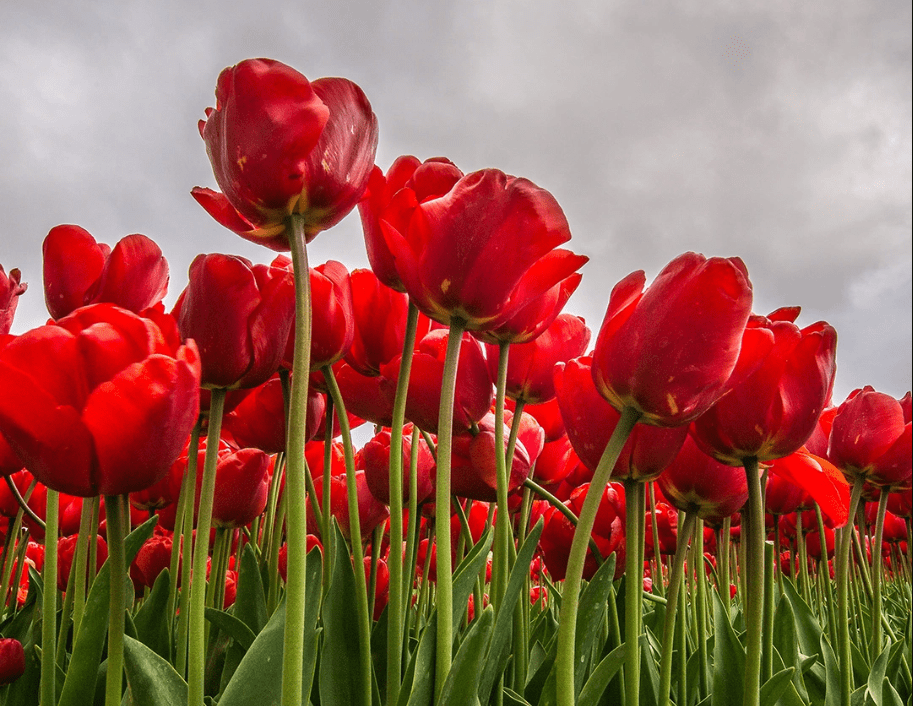
Design Versatility
The true magic of red lies in its versatility. Whether you crave the timeless elegance of red roses or the architectural grandeur of red Japanese maples, there’s a red plant to suit every taste and garden style. Red plants can be incorporated as focal points, create stunning borders, breathe life into containers, or add drama with vertical elements. The options are endless!
Beyond Aesthetics
Red plants aren’t just beautiful; they’re beneficial too! Many red flowering varieties are irresistible to butterflies and hummingbirds, attracting these vital pollinators to your garden and creating a captivating display of life and movement.
A Touch of Drama
Red is the color of passion, excitement, and undeniable drama. By incorporating red plants into your landscape design, you’re not just adding color; you’re creating a space that evokes emotion and sparks conversation. A fiery red Japanese maple silhouetted against the evening sky or a vibrant red border bursting with blooms – these elements add a touch of the extraordinary to your everyday garden experience.
So, if you’re looking to transform your outdoor space from pleasant to phenomenal, consider the transformative power of red plants. Embrace the boldness, explore the versatility, and unlock a world of fiery beauty in your garden. With a little planning and creativity, you can create a landscape that’s not just beautiful, but unforgettable.
Frequently Asked Questions
Red plants are popular because they add bold color and vibrancy to outdoor spaces. They can create focal points, attract beneficial pollinators, and evoke feelings of passion and energy.
There are many types of red plants to choose from, including roses, geraniums, dahlias, maple trees, and more. Each plant has its own unique characteristics and care requirements.
Red plants vary in their care needs, but many are relatively easy to care for. It’s important to research the specific requirements of each plant, including sunlight, water, and soil preferences.
Red plants can be used in various ways in landscape design, such as creating focal points, adding accents to borders or containers, or planting in mass for dramatic effect. Consider the overall style and theme of your landscape when choosing red plants.
Red plants not only add visual interest to the garden but also attract beneficial pollinators like birds, bees, and butterflies. Additionally, the color red can evoke feelings of excitement and warmth, creating a vibrant and dynamic atmosphere.
Planting red flowers that produce nectar and pollen is a great way to attract pollinators. Be sure to choose varieties that are native to your area and provide a mix of plant types to support a diverse range of pollinators.
Proper watering, fertilizing, and pruning are important for maintaining the health and beauty of red plants. It’s also essential to monitor for pests and diseases and address any issues promptly.
Yes, many red plants can be grown successfully in containers, including roses, geraniums, and dahlias. Just be sure to choose a container with adequate drainage and use a high-quality potting mix.
